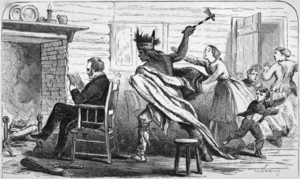Whitman massacre facts for kids
Quick facts for kids Whitman Massacre |
|
|---|---|
| Part of the Cayuse War | |

Dramatic depiction of the incident, from Eleven years in the Rocky Mountains and a life on the frontier by Frances Fuller Victor.
|
|
| Location | Waiilatpu mission, near Walla Walla, Washington |
| Coordinates | 46°02′32″N 118°27′51″W / 46.04222°N 118.46417°W |
| Date | November 29, 1847 |
| Deaths | 13 |
| Assailants | Tiloukaikt, Tomahas, Kiamsumpkin, Iaiachalakis, and Klokomas |
| Motive | The belief that Marcus Whitman was deliberately poisoning Native Americans infected with measles |
The Whitman Massacre (also known as the Walla Walla Massacre or the Whitman Incident) was a tragic event that happened on November 30, 1847. It involved the deaths of Marcus Whitman and his wife Narcissa, who were missionaries in Washington. Eleven other people also died. Members of the Cayuse tribe were responsible for the killings. They believed Marcus Whitman, who was a doctor, was poisoning their people. Many Cayuse were dying from measles, and they blamed him.
This event took place near the city of Walla Walla, Washington. It was a very important and sad moment in the history of the Pacific Northwest. The incident led to a conflict known as the Cayuse War. Marcus Whitman had helped lead one of the first groups of wagons. They traveled across the Blue Mountains to reach the Columbia River. This journey was part of the famous Oregon Trail.
The massacre was the result of many years of complicated interactions. These interactions were between the Whitmans and the local Native American tribes. The news of the killings shocked the United States Congress. This led Congress to quickly decide the future of the Oregon Country. The Oregon Territory was officially created on August 14, 1848.
Historians often explain the killings as a result of different cultures clashing. It was also due to Dr. Whitman's inability to stop the spread of measles. The Cayuse people held Whitman responsible for the many deaths that followed. This event is still debated today. Some people see the Whitmans as brave pioneers. Others view them as settlers who tried to force their religion on Native Americans. They are also seen by some as people who intruded on Native lands.
Contents
What Caused the Whitman Massacre?
The main reason for the massacre was a terrible measles outbreak. This disease spread quickly among the Cayuse people. Many Cayuse, especially children, died from it. Marcus Whitman was a doctor. He tried to help the sick Cayuse people. However, he could not stop the disease from spreading.
The Cayuse people did not understand how diseases like measles worked. They believed that Whitman was using his medicine to poison them. This belief grew stronger as more and more of their people died. This misunderstanding, along with other tensions, led to the tragic attack.
Clash of Cultures and Beliefs
The Whitmans were Christian missionaries. They came to the Pacific Northwest to teach their religion. They also wanted to introduce new ways of farming. The Cayuse people had their own traditions and beliefs. They felt that the Whitmans were trying to change their way of life.
There were also disagreements over land and resources. As more American settlers arrived, the Cayuse worried about their future. These cultural differences and fears added to the tensions. They created a difficult situation for everyone involved.
The Oregon Trail and Settlement
The Whitman mission was an important stop on the Oregon Trail. This trail was a long route for pioneers. They traveled from the eastern United States to the West. Marcus Whitman helped many settlers on their journey. He guided the first wagon train through the Blue Mountains.
As more settlers came, the Native Americans felt their lands were being taken. The arrival of new diseases also caused great suffering. These factors created a lot of stress. They contributed to the conflict between settlers and tribes.
After the Massacre: The Cayuse War
The Whitman Massacre immediately led to the Cayuse War. This was a conflict between the Cayuse tribe and the American settlers. The war lasted for several years. It involved many battles and negotiations.
The U.S. government sent soldiers to the region. They wanted to punish those responsible for the massacre. They also wanted to protect the settlers. The war ended with the Cayuse leaders being captured and put on trial. This war changed the relationship between Native Americans and settlers in the Pacific Northwest.
Legacy and Remembrance
The Whitman Massacre is a significant event in American history. It highlights the challenges and conflicts. These conflicts happened as the United States expanded westward. It also shows the tragic impact of disease on Native American populations.
Today, the site of the mission is a National Historic Site. It is called the Whitman Mission National Historic Site. It helps people learn about the lives of the Whitmans. It also teaches about the history of the Cayuse people. It reminds us of the complex past of the American West.


